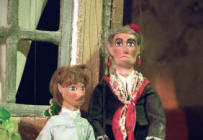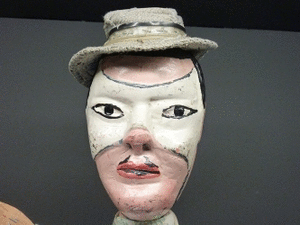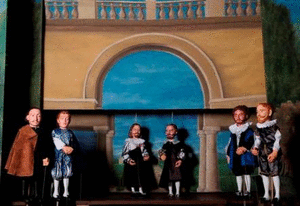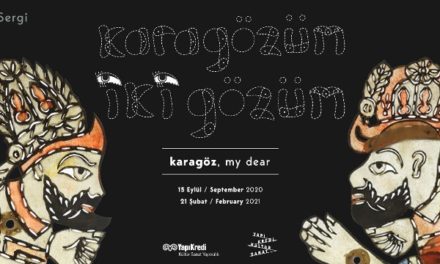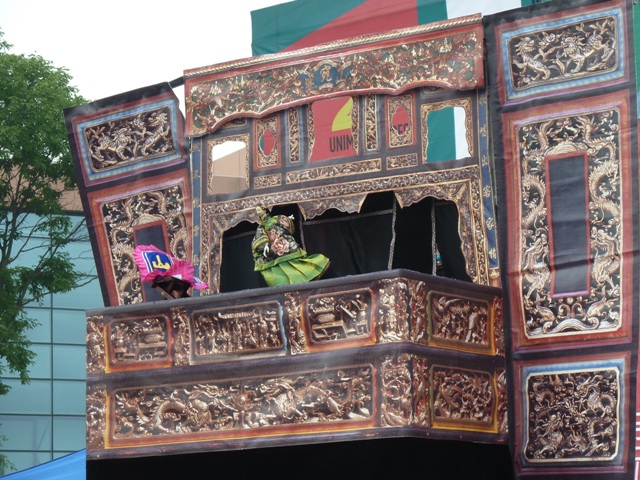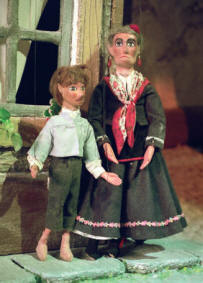 The marionettes of Tia Norica (Aunt Norica) have the honour —which incidentally is well deserved— of being one of the best studied phenomenon in Spanish puppet-theatre history. The first person to write at any length about them is the Cadiz scholar José María León y Domínguez who, in a book of personal essays (Recuerdos gaditanos, Recollections of Cadiz, 1897), dedicates a substantial chapter to the subject. The specialist in folklore, Arcadio de Larrea, published two works, (Revista de Dialectología y Tradiciones Populares, 1950 and 1953), in which he recounted various historical facts and published a number of the original playscripts. But the most important and beautiful book would appear two decades later when, with the company already a thing of the past and the marionettes in storage, various people (John Varey, Lauro Olmo, José María Pemán, Herman Bonnin —who published an article in La Vanguardia—, and others) began to pull strings so that this essential legacy of Spanish theatre would not go down the drain of legend on its way to total oblivion. Carlos Aladro created a vivid book (La tía Norica de Cádiz, 1976) in which his heart beat could be heard as he picked up those old, moth-eaten marionettes, and also, much more importantly, the voices of those who had given life to them in the past —a number of elderly puppeteers who did not have long to live. Their testimonies, with the inevitable errors of memory and personal judgements, provide precious sign-posts for those trying to interpret this artistic history which is still capable of giving many surprises. The book played an important part in the Ministry of Culture’s subsequent decision to purchase the Tia Norica legacy (1978) to be exhibited in the Museum of Cadiz, and in the re-creation of the company (1984-85). The direction of the company was entrusted to Pepe Bablé, a man of the theatre descended from previous generations of puppeteers who had breathed life and humour into the marionettes.
The marionettes of Tia Norica (Aunt Norica) have the honour —which incidentally is well deserved— of being one of the best studied phenomenon in Spanish puppet-theatre history. The first person to write at any length about them is the Cadiz scholar José María León y Domínguez who, in a book of personal essays (Recuerdos gaditanos, Recollections of Cadiz, 1897), dedicates a substantial chapter to the subject. The specialist in folklore, Arcadio de Larrea, published two works, (Revista de Dialectología y Tradiciones Populares, 1950 and 1953), in which he recounted various historical facts and published a number of the original playscripts. But the most important and beautiful book would appear two decades later when, with the company already a thing of the past and the marionettes in storage, various people (John Varey, Lauro Olmo, José María Pemán, Herman Bonnin —who published an article in La Vanguardia—, and others) began to pull strings so that this essential legacy of Spanish theatre would not go down the drain of legend on its way to total oblivion. Carlos Aladro created a vivid book (La tía Norica de Cádiz, 1976) in which his heart beat could be heard as he picked up those old, moth-eaten marionettes, and also, much more importantly, the voices of those who had given life to them in the past —a number of elderly puppeteers who did not have long to live. Their testimonies, with the inevitable errors of memory and personal judgements, provide precious sign-posts for those trying to interpret this artistic history which is still capable of giving many surprises. The book played an important part in the Ministry of Culture’s subsequent decision to purchase the Tia Norica legacy (1978) to be exhibited in the Museum of Cadiz, and in the re-creation of the company (1984-85). The direction of the company was entrusted to Pepe Bablé, a man of the theatre descended from previous generations of puppeteers who had breathed life and humour into the marionettes.
Neither these studies, nor those undertaken later by Toscano (in Cádiz y su provincia, 1985) or by Desiré Ortega, the company’s official chronicler whose Sainete de la Tía Norica. Edición crítica, introducción y notas, 2004, is the most extensive and detailed study of them all, and a prelude to a doctoral thesis which many of us are looking forward to reading, speak about one of those surprises I mentioned earlier: performances of the ineffable Tía Norica and her hilarious stories weren’t limited to the Bay of Cadiz area, but went as far as Madrid during three consecutive seasons, from 1838 to 1841.
Tía Norica had good legs at the time – her puppet character wouldn’t have been very old. Although some situate her first appearance in 1815, or even earlier, the first extant recorded reference to her is found in the newspaper the Diario Mercantil de Cádiz of 25th December, 1824: “concluding with various performances, among them Tia Norica’s Will and an exquisite dance by blacks (Marionettes)”. The little theatre in which the performance took place was located in Compañía street, and belonged to the Montenegro family. In Cadiz, as in all of Spain, there were certainly an abundance of representations using mobile figures (marionettes and simple automata) of the Nativity of the Baby Jesus, from the eighteenth century, (John Varey from Britain collects references in profusion). These representations would take place on 25th of December and 2nd of February, at that time the very popular religious feast day of Candlemas.
As with any theatrical performance, drama or comedy, the central works were accompanied by other shorter, comic pieces (comic one-act plays), and by dances which tended to take place at the end of the session. Often, these dances and short plays attracted a bigger audience than the the principal work. Thus it happened that one day somebody had the idea of following the performance of the Nativity play with a short play (sainete) about an old woman who is caught by a bull, is injured and, – given the gloomy prognosis offered by the outlandish physician Don Reticurcio, (a name in which some have seen the origen of the Spanish word cursi) -, makes a hilarious will. It was so succesful that it survived, with few interruptions, for nearly two hundred years. There were thousands of Nativities with puppets, and the majority had a grand finale of puppets that danced or performed short comedies, more or less successfully. But Nativities with Tia Norica for the final course, were only to be found in Cadiz. Or so it was believed until now.
New traces of Tia Norica
A little more than two years ago, I had one of those joyous experiences which make the pulse of boring library creatures race. The Diario de Madrid announced that in the Embajadores theatre, “in the street of the same name, number 18, first floor”, one of those little puppet theatres which show the Nativity had been set up. “Today, Wednesday 26th December 1838, at four o’clock in the afternoon, after a brilliant symphony, performances will begin with the acclaimed piece Luzbel’s Cunning, the Prophecies of Daniel and the Chase of Mayor Cucharón (the name means Ladle). With the Annunciation to the shepherds at the start, Christ’s Nativity will follow at the main doorway, in which the adoration of the said shepherds and the Holy Kings will be seen, while the whole performance will end with the comic one-act play of aunt Norica and the doctor don Roticurcio (sic)” There was no doubt in my mind but, just in case, I re-read the Nativity of the Messiah which Arcadio Larrea had published in 1953 from texts that the then owner of the Tía Norica, Joaquín Rives, used and had doubtless inherited from the previous directors, Eximeno Chaves and Manuel Martínez Couto.
Although in the said text the prophecies were made by Isiah, the “auto” or mystery play begins with a dialogue, in the midst of smoke and flames, between Luzbel and Aztuzia, (the Devil and Cunning). The palace of Herod then appears and, a little later, three shepherds: Pernaliyo, Gilberto and Cucharón, the show-off, the one who sets himself up as mayor when Tiberius’ soldier reads the general inscription order for all Jews. Would that puppet theatre have come from Cadiz? I don’t know, but it must have come from outside the capital, because a plea for indulgence towards the show is directed at the “respectable public of Madrid”. On 13th January, and in keeping with a calendar followed by almost all puppet Nativities, the scene of the Slaughter of the Innocents is added, follwed by a visit to the sea which ends in a “great storm in imitation of nature and the shipwreck of the boat boarded by aunt Norica and her husband Tarigo.” Some days later, it is clarified that the husband is uncle Tarugo. This is a sensational surprise, because no record exists of this character in the Cadiz tradition. The Nativity had its last performance on Sunday 3rd February, following the scrupulous custom of closing the cycle around the Candlemas feast day.
That it was not just a fleeting visit is confirmed in the following 1839-1840 season. The Diario de Madrid newspaper notes that in the New theatre at number 8, first floor, Reina street, there will be performances of the mystery of Christ’s birth, from 24th December, “with the assurance of improved performances in all ways, that merited such long and repeated applause last year in Embajadores street” (not active on the dates of this occasion). On the first days there is no mention of Tía Norica, but on 29th December it is stated that “apart from that which has been announced until now, there will be staged the delightful and amusing piece of aunt Norica, don Roticurcio (sic) and a bull from Gaviria.” It will be on stage until at least the 23rd January. In February 1840, the theatre continues with performances of plays, almost certainly of marionettes, but with other subject matter. I haven’t been able to find out whether it was with the same puppeteers or a new company.
In the 1840-1841 season, the theatre in Reina street continued with a moving-figures Nativity, but it is not our one because this has moved to the theatre at number 1, calle de la Sartén y Plazuela de Navalón. Besides the Nativity, divided into six scenes, mention is made of “the very funny piece of Tía Norica who is caught by a bull” (Diario de Madrid, 29-12-1841). Later, once again there will appear “a beautiful view of the sea, in which aunt Norica and don Roticurcio drown”. And there it will stay at least until Sunday 24th January. During the following season, I can no longer see any trace of aunt Norica in Madrid.
I was assailed by a thousand doubts. For example, would the Montenegro family really have left Cadiz without Tia Norica performances for three Christmases? (something that would be denied by all those involved in the tradition), or was it a different company that took the road to Madrid? If so, was this second company from Cadiz, or did they learn the Nativity mystery play (auto) and Tía Norica “sainete” in Cadiz? Since Cadiz is a long way from Zaragoza, I wrote to Juan Antonio Fierro, author of a very interesting little book (Noticias sobre los títeres de la Tía Norica de Cádiz en el siglo XIX – News about the Tia Norica of Cadiz puppets in the nineteenth century, 2004), which agrees with many of the texts by Desiré Ortega published in the same year. I asked Fierro to clarify whether the Cadiz press had collected information about these Nativity performances given in any of these three seasons. Shortly afterwards, with unfailing generosity and elegance, having gone through the Cadiz press of this period, he sent me photographs of El Nacional showing the 1840-41 season in which performances of Tia Norica appeared, on the same dates as those in Madrid. Dilemma resolved: there were two companies. Fierro was as surprised as I was, and even more so by the strange character of Don Tarugo. He told me he had his doubts as to whether the Madrid performances were actually with puppets. My dear friend, said I, this doubt exists only in your Cadiz inhabitant’s heart which refuses to recognise the obvious fact: in the middle of the nineteenth century Tía Norica had a double; and one of the two aunt Noricas took a pony and covered trap in order to cross the gorge of Despeñaperros and reach Madrid. And reach it, she did!
Translation: Rebecca Simpson

